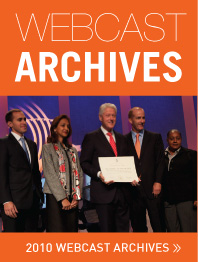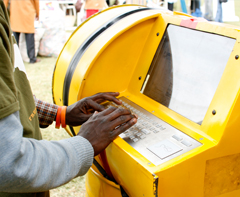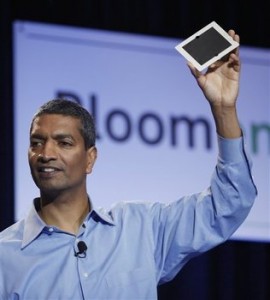
Enhancing Access to Modern Technology
Clean Technology and Smart Energy: Deploying the Green Economy
Democracy and Voice: Technology For Citizen Empowerment and Human Rights
Mobile Revolution: Transforming Access, Markets, and Development

Engineering for Change is an online environment bringing together engineers and other problem solvers with NGOs and local communities to address basic quality of life issues such as access to clean water, electricity and proper sanitation. Also see their Twitter feed
Related:
+ Engineers Without Borders
+ Architecture4Humanity
+ Open Architecture Network
+ Entrepreneurial Design for Extreme Affordability
+ D-Lab @ MIT
+ Wisdom from Paul Polak on How to Design for the Market
 Maker Faire Africa is a celebration of African ingenuity, innovation and creation. Here you will find the Makers who showed their work at the 2010 event in Nairobi Kenya. Work ranges from time saving devices for agriculture to alternative energy sources from design with recycled objects to social media applications for mobile phones. Per maker you will find a short synopsis of their work, their contacts details plus a possibliity to collaborate with them.
Maker Faire Africa is a celebration of African ingenuity, innovation and creation. Here you will find the Makers who showed their work at the 2010 event in Nairobi Kenya. Work ranges from time saving devices for agriculture to alternative energy sources from design with recycled objects to social media applications for mobile phones. Per maker you will find a short synopsis of their work, their contacts details plus a possibliity to collaborate with them.
|

Terra Weikel from Uganda came with briliant idea on how to improve the digitalization of rural Uganda, and they concluded that the best material would be to use a drum which is readily available. They then converted it into a digital tank (kiosk). He was here to create awareness of the digital drum and inspire its use in other African Villages! To inspire for a better Africa, in terms of digitalization.
|
|
|
|

The Village Telco is an initiative to build low-cost community telephone network hardware and software that can be set up in minutes anywhere in the world. No mobile phone towers or land lines are required. He was here to create awareness of the product and it entrepreneurial sense! To inspire for a better Africa, in terms of Tele-communication.
|
|
|
|
By Gary Anthes, ComputerWorld, October 21, 2008
By most measures, the U.S. is in a decade-long decline in global technological competitiveness. The reasons are many and complex, but central among them is the country's retreat from long-term basic research in science and technology, coupled with a surge in R&D by countries such as China.
Tip of the Hat to Lynn Wheeler at LinkedIn.
Phi Beta Iota: This ties in perfectly with US secret intelligence fraud, waste, and abuse (hand-outs to corporations for vapor-ware, see our quick study 2010: OPINION–America’s Cyber Scam); and also with Chuck Spinney's long-standing concerns about the plans-reality mismatch and the criminal insanity of raising two generations of engineers who know nothing but “government specification cost plus” production.
I was wondering if this discovery has a practical application. A commenter has the same question, someone else answers:
The implication of the addition of an ‘additive’ to disassemble into a liquid ‘soup’ is that the stuff can be sprayed/painted onto a surface. It also means that it can be mixed with polymers and woven into materials etc.
Paint or spray your house/car/boat/aircraft with it, and decide you want a different colour? No problem, spray the additive/solvent and it comes off.
(Thanks to Audrey Thompson for the pointer.)
Phi Beta Iota: This takes biomimicry to a very high level. Consider that Nokia now has cell phones that do not need the electrical grid–they repower from ambient energy. Consider that foot (walking) power can now go easily into a battery on the belt from which various peripherals including a cell phone can be powered. What is finally happening, in the nick of time, is the discovered of whole systems engineering. There is no need to hack the planet, the planet was perfect before we got here–we are finally hacking humanity and evolving our consciousness in a better direction.

Current BloomEnergy Website Solid Oxide Fuel Cells
20100904 Bloom Energy and Bloom Box Fuel Cell, IPO, and Stock Symbol Updates
20100226 Bloom Box Video: K.R. Sridhar Bloom Energy press conference
20100224 UK Launch of the Bloom box fuel cell generates a slice of Apple hype
20100224 CBS on YouTube Bloom Box Unveiled (30 second advertisement first, bear with it)
20100221 60 Minutes The Bloom Box
20100219 CBS on YouTube A Peek Inside the Bloom Box (30 sec)

Phi Beta Iota: A trusted source tells us that EBay is deriving one quarter of its Headquarters energy from these boxes, which are–at this point–actually more expensive than grid electricity but much less hazardous to the planet than coal. The price point can be expected to drop dramatically and no longer require subsidies. What is fascinating to us is that it is the really big global grid operators, including Google, that are jumping on this–the most intense and sustained “heat” in the 21st Century appears to come from C4I grids, and these folks are getting a ten year jump on the marketplace.

Energy in the developing world
Technology and development: A growing number of initiatives are promoting bottom-up ways to deliver energy to the world’s poor (Sep 2nd 2010)
AROUND 1.5 billion people, or more than a fifth of the world’s population, have no access to electricity, and a billion more have only an unreliable and intermittent supply. Of the people without electricity, 85% live in rural areas or on the fringes of cities. Extending energy grids into these areas is expensive: the United Nations estimates that an average of $35 billion-40 billion a year needs to be invested until 2030 so everyone on the planet can cook, heat and light their premises, and have energy for productive uses such as schooling. On current trends, however, the number of “energy poor” people will barely budge, and 16% of the world’s population will still have no electricity by 2030, according to the International Energy Agency.
But why wait for top-down solutions? Providing energy in a bottom-up way instead has a lot to recommend it. There is no need to wait for politicians or utilities to act. The technology in question, from solar panels to low-energy light-emitting diodes (LEDs), is rapidly falling in price. Local, bottom-up systems may be more sustainable and produce fewer carbon emissions than centralised schemes. In the rich world, in fact, the trend is towards a more flexible system of distributed, sustainable power sources. The developing world has an opportunity to leapfrog the centralised model, just as it leapfrogged fixed-line telecoms and went straight to mobile phones.
Continue reading “Bottom-Up Energy: Wait Not/Rely Not on Government & Industry”